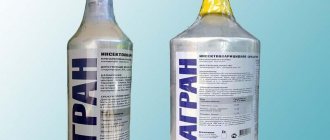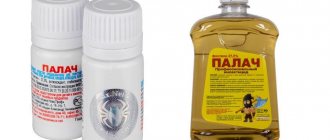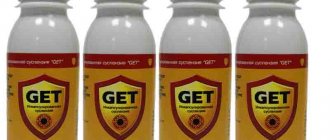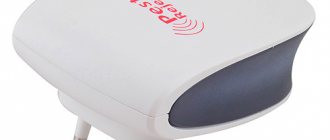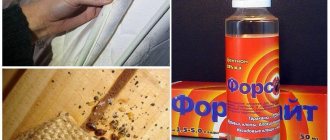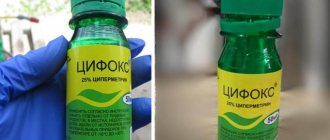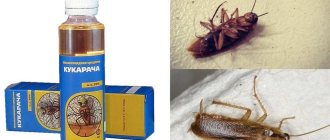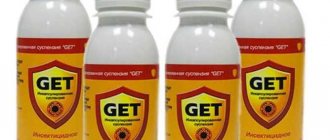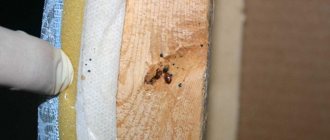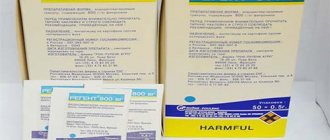Wofatox
An organophosphate preparation for exterminating a whole range of household and garden pests.
Advantages.
- Very cheap insecticide (.
- Economical product. One ampoule is diluted in 10 liters of water.
Flaws.
- Wofatox bedbug repellent has a strong unpleasant odor.
- You must first prepare a working solution.
How to apply?
Dilute an ampoule (5 ml) in a bucket of plain water, pour into a container with a spray bottle and treat the bedbugs’ places of residence. Leave the drug for several hours or overnight, then ventilate the room and wash off the product with a solution of soda and soap.
Photo of Votafox:
Precautions when working with Blockade-Antiklop.
- Wear a gown, rubber gloves and a respirator or protective mask.
- Before processing, remove people and pets from the premises.
- Cover the aquariums, put food and dishes in the closet.
- Carry out the treatment with the windows open, and after finishing, ventilate for at least half an hour.
- Carry out complete wet cleaning after 24 hours. Wipe all contact areas with soap and soda solution.
- Send work clothes for washing, wash hands and face with running water and soap.
- Store the product out of the reach of children and animals.
Anticlope blockade is available in containers from 50 ml to 1 liter, the price for 50 ml is 350-400 rubles, for 1 liter about 2000 rubles. The average consumption of working emulsion is 100 ml per 1 m2.
– Are cockroaches insects or animals? – If they live with a neighbor, they are insects, and if they live with you, then they are animals.
Safety
At the same time, drinking, smoking and eating are prohibited. Children and pets are prohibited from being in the area being treated. After all the manipulations, you need to change clothes, wash your face and hands with soap, and take a shower. Store in a dark and dry place, away from medications and food.
Means of protection
Working with an insecticidal solution requires the following precautions:
- The use of personal protective equipment (rubber gloves, mask or respirator, goggles and as closed clothing as possible) is mandatory.
- 2It is strictly prohibited for people and pets to remain indoors during treatment. The effectiveness of the procedure largely depends on the preliminary preparation of the premises for disinfestation. Food, dishes, children's things and toys must be taken out of the room or placed in tightly closed cabinets. Large aquariums and indoor flowers are covered with film.
- Disinfestation should be carried out with the window open. At the end of the process, the room is thoroughly ventilated.
- A day after treatment, the room is wet cleaned using a soap-soda solution and rubber gloves.
- If the insecticide accidentally gets on the skin or mucous membranes, it is washed off with plenty of water.
You can order Blockade Antiklop on the Internet or purchase it in a specialized store.
Compound
The active substance is the neonicotinoid acetamiprid. In its pure form, acetamiprid is a white crystalline powder, which is used as the active ingredient in many modern insecticides and pesticides. As a pesticide, acetamiprid is not safe for humans because it tends to accumulate in plants, which are then consumed as food. But as an insecticide it is quite effective.
Acetamiprid is characterized by a contact action, so it cannot, but its long-lasting protective effect, durability and low consumption make it very popular among professional exterminators.
The substance belongs to class III hazard or moderate toxicity. In small doses, this neonicotinoid is practically harmless, but when systematically introduced into the body it has a carcinogenic effect. In large doses, acetamiprid causes tremors, diarrhea, and convulsions.
Features of the drug
Blockade Antiklop is an antiparasitic drug of moderate toxicity class, used for treating residential premises, as well as public places (hospitals, hotels, dormitories). The active ingredient is the neonicotinoid insecticide acetamiprid (5%). It also contains functional additives that enhance the effect of the active component. The drug is a concentrated liquid emulsion of a light color, bottled in vials or plastic bottles.
Antiklop blockade
Anyone who is faced with a problem such as parasites is concerned with the question of whether the drug helps against bedbugs. Many consumers leave positive reviews about Blockade Antiklop, as the product has a number of advantages:
- effectiveness - the drug has a very powerful insecticidal effect and acts even on resistant bugs,
- if the room is moderately infested, re-treatment is not required,
- affordable cost - the price of Blockade Antiklop varies depending on the volume of the package: 50 ml cost about 300 rubles, 1 liter - about 2,000 rubles.
The only drawback is the need to prepare a solution.
Acetamiprid
CAS number:
135410-20-7 (160430-64-8)
Gross formula:
C10H11ClN4
Appearance:
white crystalline powder.
Chemical name and synonyms:
Acetamiprid, (1E)-N-[(6-Chloro-3-pyridinyl)methyl]-N'-cyano-N-methylethanimidamide.
Physical state:
Molecular weight 222.68 g/mol Density 1.17 Melting point 101-103 ° C Boiling point 352.4 ° C at 760 mm Hg. Solubility in water: slightly soluble. Solubility at 25 ° C = 3.48 * 103 mg/l Soluble in acetone, methanol, ethanol, dichloromethane, chloroform, acetonitrile and tetrahydrofuran. Partition coefficient: n-octanol/water log Pow: 0.8 at 20°C (68°F) Gas pressure 4.4X10-5 mmHg at 25 deg. C / Calculated / Stable in buffer solutions at pH 4, 5, 7. Slowly decomposes at pH 9 and 45 ° C. Stable in sunlight. Soil sorption (Kd = ml/g) from 0.39 to 4.1
Description:
Acetamiprid is an insecticide belonging to the chemical class of chloropyridinyl neonicotinoids. A relatively new class of insecticides, developed in the mid-1980s, introduced into the agricultural arsenal as insecticides only in the early 1990s.
Acetamiprid is a member of the neonicotinoid insecticide family. Neonicotinoids are a class of neuroactive insecticides that are chemically similar to nicotine. They target the insects' nervous system, causing paralysis. Acetamiprid is indicated for the control of sucking insects on crops such as leafy vegetables, citrus fruits, pome fruits, grapes, cotton, cabbage and ornamentals. It is also a key pesticide in commercial cherry production due to its effectiveness against the fruit fly larvae, aphids and whiteflies that attack the tree without causing harmful effects on non-targets. Acetamiprid is also used to control household pests, such as bed bugs.
Neonicotinoids, like nicotine, bind to a cell's nicotinic acetylcholine receptors and trigger a response from that cell. In mammals, nicotinic acetylcholine receptors are located in cells of both the central and peripheral nervous systems. In insects, these receptors are limited to the central nervous system. While low to moderate activation of these receptors causes neural stimulation, high levels overstimulate and block the receptors, causing paralysis and death. Nicotinic acetylcholine receptors are activated by the neurotransmitter acetylcholine.
Because most neonicotinoids bind much more strongly to insect neuronal receptors than to mammalian neuronal receptors, these insecticides are selectively more toxic to insects than to mammals.
Neonicotinoids are effective as foliar and seed or soil treatments. They have low hydrophobicity, which is associated with their excellent systemic and translaminar activity.
Studies have been conducted on the effectiveness and toxicity of acetamiprid on various types of pests, as well as on non-target (beneficial) insect species. Thus, one of the works of researchers Marilina N. Fogel • Marcela Ine´s Schneider • Nicolas Desneux • Bele´n Gonza´lez • Alicia E. Ronco dated June 12, 2013 is devoted to Eriopis connexa (a widespread species of ladybird beetles in South America ), a beneficial predator of aphids in the neotropical region. These pests are usually controlled using newly developed systemic insecticides such as neonicotinoids. However, compatibility between selective pesticides and natural enemies is necessary before including them in integrated pest management (IPM) combination formulations. The purpose of this study was to evaluate the adverse effects of different concentrations/doses of one commonly used neonicotinoid in vegetative crops, acetamiprid, on immature stages of E. connexa (by dipping or topical application on eggs and larvae, respectively). Acetamiprid reduced egg hatching from 34 to 100%. In addition, embryogenesis was impaired by the insecticide in the early embryonic stage at all concentrations tested. The second instar was more susceptible to acetamiprid than the fourth instar, and this susceptibility was positively associated with the concentrations tested. On the other hand, the reduction in survival rate during the larval stage reached 100% of 20 mg/day/L (10% of the maximum field concentration). In addition, female reproduction from thematic biological assays on fourth instar larvae was severely affected, with fecundity and fertility declining from 22 to 44% and from 37 to 45%, respectively. Overall, the results showed high toxicity of acetamiprid to immature stages of E. connexa, demonstrating that this widely used insecticide can reduce the biocontrol of these beneficial insect predators and disrupt IPM programs.
Application:
Acetamiprid is a systemic substance intended for the control of insects of the order Lepidoptera, thrips (Thysanoptera), hemiptera (Hemiptera), mainly aphids that attack cultivated and ornamental plants. It is also actively used against cherry fruit fly larvae.
The substance acetamiprid is actively used as an active ingredient in a number of insecticidal agents used to control pests in agriculture, as well as at home to control fleas in cats and dogs.
Receipt:
The method for producing acetamiprid includes the steps of allowing the interaction of 2-chloro-5-chloromethylpyridine and an aqueous solution of methylamine in order to synthesize N-(6-chloro-3-pyridylmethyl)methylamine; ensuring the reaction of acetonitrile, ethanol and cyanamide for the synthesis of ethyl-N-cyanoethanimidate and then the synthesis of acetamiprid from N-(6-chloro-3-pyridylmethyl) methylamine and ethyl-N-cyanoethanimidate. There is also a method for synthesizing acetamiprid using new technology. It includes the following steps: benzylmethylamine and ethyl N-cyanoethanimidate are added to a flask equipped with a stirrer, thermometer and device for absorbing residual gases, provided that methanol is used as the solvent, the temperature is heated to 65 DEG C, the reaction continues for 5 hours ; Acetone is also used to elute and obtain acetamiprid. In the new synthesis technology, the weight ratio of benzylmethylamine to ethyl-N-cyanoethanimidate is 150: 110; the synthesis yield can be increased from 90% to 95%, and the product purity from 96% to 98%.
Effect on the body:
Acetamiprid, like other types of neonicotinoid insecticides, were developed by modifying nicotine. These modifications include nitromethylene, nitroimine or cyanoimine and provide better potency and stability than nicotine. Acetamiprid is a nicotinic agonist that reacts with nicotinic acetylcholine receptors (nACh-R). These receptors are located on the postsynaptic dendrites of all neurons in the brain, spinal cord, ganglia and muscles. Activation of nACh-R receptors causes hyperactivity, muscle spasms, and ultimately death. Acetamiprid is almost inactive as a contact insecticide, but it penetrates and distributes well to parts of the plant, including the growing tip of the plant, and affects the insect that feeds on the plant. The pest pierces it with its mouthparts (this may be a proboscis, like an aphid). Acetamiprid is toxic and quite selective to insects, with comparatively less pronounced toxicity to mammals. Acetamiprid has virtually no effect on humans, but potential toxicity is still possible, so it is important to prevent the uncontrolled use of pesticides in agriculture and agro-industrial production.
Toxicological data:
Acute toxicity
LD50 skin application, rat -> 2000 mg/kg
Ecotoxicity:
Toxicity to fish LC50 - Cyprinus carpio (common carp) -> 100 mg/l - 96 h
Application
Before starting disinfestation, a number of preparatory measures need to be carried out.
- Clean up, vacuum.
- Move furniture away from the walls.
- Cover aquariums, terrariums, insectariums tightly or take them to another room. The drug is extremely dangerous for these creatures.
- Close windows, doors, seal sockets and ventilation grilles with cling film. During the disinfestation process, bedbugs will crawl out of their hiding places and try to escape. To prevent this from happening, it is necessary to ensure complete tightness.
- There should be no pets or other people in the house.
- Hold the spray gun at arm's length at a distance of 20 cm from the surface to be treated.
- Upon completion, leave the house or apartment closed for 2 hours.
- Ventilate thoroughly and clean areas where hands may touch.
Antiklop blockade against bedbugs
bedbug eggs
Preparation
At the first stage, regardless of whether you invite a professional team (read more about bedbug extermination services here) or do the treatment yourself, inspect the premises in those places where family members spend the night.
These areas contain the maximum concentration of bedbug colonies: beds, sofas, bedside rugs, baseboards, heating appliances, window sills.
Their hiding places are cracks, loosely fitting upholstery, the back of carpets, loosely fitting wallpaper, and hollow baseboards. These are risk areas where residents do not periodically clean the premises and furniture.
At the second stage, you need to prepare the room for processing. Move all furniture away from the walls to make it easier to handle from the back. Remove bedding and underwear. Pack children's toys, dishes and food tightly and remove them from the treated area. All animals must be removed or removed during insecticide treatment. Seal the aquarium tightly and turn off the air supply to the aquarium.
The room must be processed using protective clothing:
- robe, suit;
- for the head, a scarf, a cap;
- rubber gloves;
- oilcloth apron;
- sleeves;
- respirator;
- protective glasses.
Attention. Work without a respirator is allowed if no more than 100 cm3 of the prepared solution is used per day.
In children's institutions, the preparation process is the same, and processing is carried out on sanitary days or weekends. In medical institutions, all patients are evacuated before disinfestation.
Useful materials
Read other articles about bedbugs:
- Find out the main reasons for the appearance of bloodsuckers in the apartment, namely bed parasites.
- What do house bugs look like and how to get rid of them using various methods?
- Find out why they are dangerous for humans? How to recognize their bites, especially in children, and how to properly treat the damaged areas?
- To effectively combat these insects, find out what species there are, how they reproduce and feed, where you can find their nests and can they live in clothes?
- Read more about folk remedies, in particular vinegar and temperature effects.
- Effective preventive measures.
- Check out a few review articles on the best treatments for bed bugs in particular. Check out the list of products that are safe for people and pets, and also find out how to properly prepare your apartment before treatment.
- If you cannot cope with parasites on your own, we recommend turning to professionals. They have effective destruction technologies and will be able to help you in the shortest possible time.
Below is a list of drugs that have proven themselves (can be used independently):
- Powders and dusts: Clean House, Karbofos.
- Chalk Mashenka.
- Sprays: Tetrix, Get, Tsifoks, Forsyth, Fufanon, Cucaracha, Executioner.
- Aerosols: Raid, Raptor, Combat.
Materials from the section Remedies for bedbugs
Popular remedies for bedbugs at home: how to get rid of insects in an apartment, advantages and disadvantages of various chemicals
Let's look at bed bug remedies: which are the most effective, application features, their pros and cons
No bedbugs! Review of modern bed bug remedies
Review of modern insecticides: the best home remedies for bedbugs
Does dichlorvos help against bedbugs? Review of aerosols and sprays on the market
“The main thing is not to harm yourself!” Bedbug repellents are safe for people and animals
Pesticides containing acetamiprid
There are quite a few acetamiprid-based products that help get rid of bedbugs and other dangerous insects. The following drugs are usually used in agriculture:
- “Agent” - used to destroy coleopteran pests that attack cereal plants and potatoes. The product is produced in the form of granules. The composition is characterized by low toxicity to humans and animals. In addition, it quickly decomposes in the soil.
- "Gazelle" - the drug is suitable for protecting rapeseed plantations. It is produced in the form of a concentrate. The composition is safe for bees and other pollinators. The composition can be used during the flowering period.
- “Snake” is considered an innovative tool for the destruction of major agricultural parasites. It is produced in the form of a soluble powder. The composition has a high rate of exposure and does not depend on climate and temperature. The substance is characterized by a pronounced systemic effect.
The following substances are suitable for personal plots:
- "Stozhar";
- "Mospilan".
What is the most effective remedy for bedbugs?
Almost anything. But, you need at least two funds. And also correctly selected.
Do you want the very best? This article has already discussed one of the options, how and with what drugs you can remove bedbugs forever.
Here we will figure out exactly how to select insecticides so that it does not cause excruciating pain for wasted money.
To successfully combat bed bugs, at least 2 treatments of the apartment with chemicals containing different active ingredients (AI) are required. DV should not only differ in name, but also be from different groups.
It is absolutely pointless to do even 2 treatments in a row with the same drug. Or 10 treatments with different drugs, but with the same active ingredient in the composition. Or simply belonging to one group.
For example, after treating an apartment with Medilis-anticlop (pyrethroids Permethrin + Cypermethrin + Tetramethrin), there is no need to use Tsifox (pyrethroid Cypermethrin) or catch up with Deltis (pyrethroid Deltamethrin). They all contain active substances of the same group - pyrethroids, and the desired effect will not be achieved. Although individually the listed drugs have excellent reviews. You just need to apply them in accordance with the funds rotation schemes given below.
Distribution of anti-bedbug products into groups
Based on the active substance, as already noted in the article, all insecticides for killing bedbugs can be divided into 6 groups:
1. Organophosphorus compounds (OPS): malathion, fenthion, diazinon, chlorpyrifos, chlorophos.
2. Neonicotinoids: imidacloprid, acetamiprid, thiomethoxam.
3. Pyrethroids containing a CN group: permethrin, cypermethrin, alphacypermethrin, deltamethrin, lambda-cyhalothrin, zetacypermethrin, cyfluthrin.
4. Pyrethroids that do not contain a CN group: tetramethrin, imiprothrin.
5. Carbamic acid derivatives: propoxur, bendiocarb.
6. Combined preparations containing a pyrethroid and an active substance from the same (or another) group.
Characteristics of each group of drugs for removing bedbugs
Carbamic acid derivatives are extremely rare in bedbug killers and are 10 times less effective than other active ingredients. But as part of combination drugs they show good results.
Pyrethroids that do not contain a CN group cause hyperactivity of bedbugs and quickly decompose under the influence of the external environment.
Application principle
Before treating a room infested with bedbugs, you must carefully read the instructions for use, since the solution can be diluted in different proportions. Instructions for use of Blockade Antiklop are located on each bottle.
Simple steps:
- To prepare a working solution, dilute 10 ml of concentrated emulsion in 1 liter of water at room temperature. If the room is overly contaminated, the dose can be doubled using 20 ml of the product.
- The prepared solution is sprayed using a spray bottle in a continuous layer in places. Most often they are upholstered furniture, beds, mattresses. Attention should also be paid to various cracks and crevices. The product is used at the rate of 100 ml per 1 sq. m.
- A brush is used to treat the absorbent surface. With its help, an insecticidal substance is applied both to upholstered furniture and to the area adjacent to it (radiators, window sills). For these purposes, a 1% solution of the product should be used.
Preparation of the solution
Produced in the form of a concentrated emulsion. How to dilute the drug is indicated in the instructions. Initially you need to purchase:
- latex gloves;
- respirator;
- choose a suitable container.
Medicine for bedbugs Blockade Antiklop The finished solution is poured into a spray bottle or a spray bottle. Blockade Anticlop can be used within three days from the date of preparation, but it is better immediately. Dilute 10 ml of the product in 1 liter of water at room temperature. This concentration is sufficient to destroy moderately infested parasites. For large numbers of bedbugs, it is recommended to double the dose. For 1 liter of liquid, 20 ml of the drug.
Important!
Instructions for use Blockade Antiklop provides for the consumption of the prepared product 50 ml on a hard surface, 100 ml on a soft surface. It is allowed to apply the solution with a brush in places where a high concentration of the product is required.
When working with the drug, it is necessary to use personal protective equipment. Violation of this requirement causes poisoning when inhaled and skin allergies.
Chlorophos
Organophosphorus universal remedy, effective against a wide range of pests, including bedbugs.
Advantages.
- It affects all stages of bedbug life, including eggs.
- It enters the body of insects not only through contact, but also through the respiratory system.
- Affordable price (900 rubles per 800 g).
Flaws.
- Chlorophos from bedbugs is highly toxic to people and pets.
- The drug must first be diluted in water.
- The product has a strong characteristic odor.
How to use?
Make a 1–2% working solution. It can be sprayed with a spray bottle or applied with a brush, carefully treating all places where bloodsuckers live. Leave the product for a day, then thoroughly ventilate all rooms and wash off the solution with water and soap diluted in it.
Photo of the drug Chlorophos:
Popular drugs
Mospilan
"Mospilan" is widely used in agriculture. Available in powder form.
It is used for spraying barley, potatoes, peas, and cucumbers in closed ground during the growing season. The effect of application is observed an hour after spraying.
The insecticide is extremely active on the leaves immediately after spraying and has a prolonged systemic effect up to 21 days.
For most plants, a single application per season is sufficient. The consumption of the drug is economical - from 0.05 to 0.2 kilograms per hectare of cultivated area.
It is used to destroy Colorado potato beetles, grain flies, pea and other varieties of aphids, leaf sawflies, and thrips.
Agent
“Agent” was created to combat coleopteran insect pests of grain and potatoes. Available in granules.
Low toxicity to humans and animals, as well as pollinating insects. Disintegrates quickly in soil.
It has a systemic effect - it is not necessary to treat the entire plant. Protection lasts up to 24 days. The drug begins to act an hour after spraying. When working near apiaries, the flight of bees is limited to three hours.
Wheat is processed during the growing season. Potatoes are sprayed before flowering or tubers are treated before planting.
Helps in the fight against Colorado potato beetles, bugs, turtles, ground beetles.
Alpha-amiprid
"Alpha-amiprid" is used to treat crops. Available in powder form, soluble in water.
Affects eggs, larvae and adult pests, causing nervous system failure. Penetrates freely into all parts of the plant, regardless of the thoroughness of the treatment. When sprayed, insects die within an hour, and the protective effect of the drug lasts twenty-one days.
Effective at normal and elevated temperatures. Does not cause addiction among pests.
It has low toxicity to bees and bumblebees.
Used to kill bugs, turtles, grain flies, ground beetles, and thrips.
Gazelle
"Gazelle" is used to protect rapeseed plantations. Available in the form of a concentrate.
Declared by the manufacturers as a safe drug for bees and other pollinators. Spraying during flowering is allowed.
The fields are cultivated during the growing season. The drug is economical to use. One hectare requires two hundred milliliters of concentrate.
Active at high temperatures.
One plant treatment is required per season.
Used to combat rapeseed flower beetles and sawflies, as well as pod gall midges.
Grinda
"Grinda" has the widest application against garden and field pests. Available in powder form.
Spraying is carried out during the growing season once per season. The drug provides protection for 21 days.
Does not lose its effectiveness in hot weather. Easily penetrates the sap flow system. Destroys pests that lead a hidden lifestyle.
The drug is able to affect insects that are resistant to other insecticides. The death of pests occurs within one day.
It affects not only adults, but also their eggs and larvae.
It has low toxicity to bees, animals and humans.
Used to protect wheat fields, potatoes and vegetable crops from sucking and leaf-gnawing pests. Including whiteflies, turtle bugs, and Colorado potato beetles.
Snake
"Snake" is one of the newest drugs for controlling agricultural pests. Available in the form of a soluble powder.
It has a high speed of action, independent of weather conditions and air temperature.
The pronounced systemic effect makes it possible to treat not all plants as a whole - the drug penetrates well into the sap flow system from any part of the shoot.
The protection period is more than three weeks. The primary effect of the drug is observed in the first hour after treatment.
Does not cause addiction among pests. Destroys individuals insensitive to other neonicotinoids.
Non-toxic for humans and animals, low toxic for bees. The use of the drug is permitted in greenhouses.
Destroys Colorado potato beetles, whiteflies, ground beetles, and turtle bugs.
Aspid
“Aspid” is used for sanitary treatment and insect control in everyday life. Available in the form of con src=»https://stopvreditel.ru/wp-content/uploads/2015/04/aspid.jpg» class=»aligncenter» width=»360″ height=»514″[/img]
Affects populations resistant to other neonicotinoids and insecticides. Not addictive.
Has intestinal and systemic effects on insects. Residual protection lasts for six weeks.
The working solution of the concentrate does not leave stains on the surfaces being treated and is completely odorless.
Does not cause irritation to mucous membranes in animals and humans.
The product is economical to use. To obtain a solution, from 0.05 to 25 grams per liter of water is required.
After spraying places where insects accumulate, the solution remains there for one day, and then is washed off with a solution of soap and soda. The drug can remain in places inaccessible to humans until the expiration date (four to six weeks).
You can treat sewer and ventilation systems, pipe joints, cracks in walls, thresholds, door frames and along baseboards. The approximate consumption of the working solution is one hundred grams per square meter of room.
This insecticide is used to fight cockroaches, ants, ticks (including rat ticks), and mosquito larvae. The product is effective against adult mosquitoes and flies.
Most tubeworms are pests of fruit crops. The rose leafhopper harms not only roses, but also rose hips. Read here how to get rid of this harmful insect.
Fruit moths eat juicy fruits in our gardens. How to get rid of this pest, read the link.
Instructions for use
Before you begin treating the premises, you need to remove all people and animals from the house (including aquariums, terrariums and bird cages). After this, remove dishes, food, cosmetics, personal hygiene products and all things from the cabinets. Remove bedding, curtains, curtains, bedspreads. They do not need to be processed. After processing at home, they simply need to be thoroughly washed and ironed at high temperature. Do a spring cleaning to apply the insecticide to walls, floors and other surfaces, not to dust. Otherwise, the effectiveness of the drug will be very low, because it will quickly be washed off. Move furniture away from the walls and wash everything behind it. Open all sofas and, if possible, dismantle all contaminated furniture. Close the doors and windows; there should be no gaps.
Protect yourself before processing. Use personal protective equipment. You will need special disposable clothing, it is inexpensive, you can wear an old raincoat or raincoat instead. You need to use a good respirator; a regular medical mask will not protect against chemical fumes. In addition, safety glasses and gloves are required. This requires some expense and preparation, but there is no other way to deal with bedbugs. Such preparation is much simpler than major renovations in the apartment and the purchase of new furniture.
The product must be applied from a distance of 10 cm from the surface. Which areas should be treated?
- Furniture (sofas, beds, armchairs, chairs, cabinets, drawers, shelves, etc.) must be treated superficially and carefully at the joints and fastenings of the upholstery. Don't forget about the backs of the furniture that are adjacent to the walls.
- Walk along the floor and all walls, paying special attention to wallpaper joints, baseboards, crevices, cracks, switches and sockets.
- Treat the insides of paintings, panels, carpets.
- Spray door frames, window openings, areas under window sills and behind radiators.
- Apply the product to the ventilation grilles.
The areas where the bedbugs were found and everything around these areas need to be treated most heavily so that the insects cannot migrate. Get away from home for 15–20 minutes. After this, go back and open all the windows to ensure the rooms are well ventilated. After another half hour, you can begin wet cleaning. Wear gloves. Wash all surfaces with which you come into active contact with a soap and soda solution, and then with clean water. It is better not to wash places behind furniture, inside furniture, under windows and the like right away. Let the substance there be concentrated.
Keep the spray out of the reach of children and animals, where it will not be heated or exposed to sunlight.
Blockade Antiklop: customer reviews
Anna, 32 years old, Saratov
I was able to destroy the bedbugs myself, I didn’t even expect it, because I had never had to do this before. It’s not difficult, or maybe it’s just the drug itself - it’s convenient to use, the consumption is average.
Marina, 38 years old, Kaluga
I bought Antiklop, but I didn’t really count on the result, because I once had to treat my apartment for cockroaches with another spray, but it didn’t help at all. But the Blockade works completely differently; in the evening I began to find dead insects everywhere.
Lesya, 39 years old, Rostov-on-Don
The bedbugs returned after treatment, literally a few weeks passed. I read it, it turns out that the drug does not protect the apartment, it quickly disappears. If you don’t want to treat your home twice, it’s better to immediately take another product to treat areas where bedbugs can enter.
Elena, 39 years old, Moscow
Antiklop is my first insect repellent at home. Don't look at the name, it's great at killing other insects too.
Anton, 35 years old, Kazan
I used Blockade for prevention - applied it to ventilation grilles, floors, especially in the bathroom next to the pipes. I also processed the windows (frame) and door block. The neighbors poisoned insects during this period, and thanks to the Antiklop product, I had a clean life.
Before processing, it is necessary to remove all personal belongings into plastic bags.
Properties
The drug BLOKADA-ANTICLOP is produced by Russian.
The insecticide is approved for production and sale in accordance with the instructions dated September 19, 2014. The certificate is valid in Belarus, Kazakhstan and the Russian Federation. The product is used independently by professional sanitary companies and the public to combat bedbugs.
This drug is allowed to be used in hospitals and children's institutions, hotels, dispensaries, sports complexes, rest homes, sanatoriums, dormitories, industrial and residential premises.
BLOCKADA-ANTICLOP is produced in transparent 50 ml bottles, in which a light yellow liquid is packaged. This drug is based on a substance that infects the parasite – the neonicotinoid acetamiprid, five percent.
The drug begins to act upon direct contact with the insect. The product has a pronounced insecticidal effect against bed bugs. Its residual effect, especially on absorbent surfaces, is not great.
BLOCKADA-ANTICLOP is classified as moderately hazardous class 3 in terms of toxicity to the gastrointestinal tract, and in contact with human skin and in terms of its volatility - in low-hazardous class 4.
Precautionary measures
Store the pre-purchased product out of the reach of children, away from food and medicines.
The shelf life of the drug is no more than 2 years from the date of manufacture. It should be stored away from heating devices. The insecticide can withstand temperatures from 20°C cold to 40°C heat.
If safety rules are not followed, symptoms of poisoning may occur:
- dizziness,
- nausea,
- abdominal pain,
- unpleasant taste.
If your eyes are accidentally treated with an insecticide, you will need to rinse them with water for 5 minutes and apply eye drops. If it comes into contact with the body, rinse the contaminated areas in running water. If you feel dizzy and it becomes difficult to breathe, immediately go outside. Then rinse your nose and mouth with soda solution, take any sorbent. If the condition does not improve, consult a doctor.
Accidentally spilled product can be neutralized with bleach.
Advantages
The main advantage of the Antiklop Blockade is its high effectiveness against bedbugs. Although the drug does not kill bedbug eggs without direct contact, its effect lasts up to 22 days and affects the insects when they hatch. In 90% of cases, the insecticide can destroy bedbugs in one application.
Unlike a number of other insecticides, “Blockade Antiklop” has no odor - it will be comfortable to be in the treated room. Lack of odor is an important factor, especially for those who have already had the pleasure of working with drugs like Karbofos.
The product is often used by professional exterminators, who are attracted not only by the effectiveness, but also by the price of “Blockade Antiklop”. One bottle of the drug allows you to treat a room of up to 100 square meters, and it costs around 300 rubles.
It is impossible not to note the versatility of the insecticide. Acetamiprid, which is part of the drug, effectively fights not only bedbugs, but also fleas, cockroaches, flies and other insects.
Being a neonicotinoid-based product, Blockade Antiklop effectively kills populations of bedbugs that have developed immunity to classical insecticides, fenthion or malathion.
The low volatility and moderate toxicity of the drug allows it to be used in hospitals and kindergartens, which is confirmed by state certification.
How to get rid of bedbugs using folk remedies
Pros:
inexpensive, some of the above are usually available at home, sometimes have natural ingredients, and are non-toxic.
Minuses:
repel and reduce the activity of bedbugs instead of total destruction, can leave stains on things and objects, have a specific odor, and be flammable.
- 9% table vinegar. Pour into a spray bottle pure or diluted with water in a ratio of 1/1 and apply to surfaces where you find clusters of bedbugs
or traces of their vital activity. - Essential oils. Bedbugs are repelled by the smells of lavender, eucalyptus, tea tree, and cloves. Oils can be left in rooms where bedbugs are found in aroma lamps for several hours.
- Aroma sticks. Many incense in this form emit a fairly concentrated aroma. Use sticks with myrrh, frankincense, sandalwood. You can try experimenting with other scents if you don't like the ones mentioned above.
- Herbs. You can repel bedbugs with dried or fresh bunches of herbs placed around the apartment. Thyme, valerian, rosemary or wormwood are suitable for this purpose.
- Alcohol-containing products. Alcohol-based household cleaning products are a more or less adequate alternative to obsolete and flammable compounds such as kerosene, gasoline and turpentine. Apply them daily only to the surfaces for which they are intended.
- Boric acid. Boric acid powder is sprinkled on all places where bedbugs and traces of their presence were found. This is the only folk method that is capable of physically destroying bedbugs, but only those individuals that have been in direct contact with the powder.
Bedbugs feed exclusively on blood, so they cannot be treated like cockroaches
feed with poisoned baits disguised as food. Parasites can only be destroyed by contact - if the toxic substance in the required quantity and high concentration reaches the body of the pest. Only special insecticides can provide this effect.
Helpful advice.
Most of the products described above affect bedbugs due to their strong odor. Based on this, you can experiment with different scents and their sources, choosing those that will not cause you discomfort, while you will have to monitor how pests will react to a particular smell.
FAS Super
Combined insecticide in the form of a wetting powder or water-soluble tablet.
Advantages.
- The combination of two active drugs is guaranteed to exterminate bloodsuckers.
- Acts as a fumigant, poisoning bedbugs in pairs.
- How the contact agent enters the body.
- It is inexpensive (100 rubles for 10 grams).
Flaws.
- The remedy for bedbugs Fas does not act on parasite eggs, therefore it requires secondary treatment after a week.
- Before use, dilute with water.
- Bedbug spray is dangerous for people and pets.
- After opening the package, it quickly loses its properties.
How to use?
Prepare the solution according to the instructions using warm water. Place the liquid in a container with a spray bottle and spray the areas infested with bedbugs. Leave for 3 hours, then rinse with water, after ventilating the room.
Photo of the FAS drug:
Local anesthetics
Substances that have an analgesic effect are used for all types of blockades, using the drug alone or in combination with other groups of medications.
Novocaine spinal blockade is performed more often than other anesthetic injections. “Novocaine” is available in the form of an injection solution with different concentrations of the active substance (from 0.25% to 2%). The analgesic effect develops a few minutes after the blockade was performed. An injection using Novocaine anesthetizes for up to 2 hours.
“Marcaine” is also used to relieve pain. The result of the administration of the drug has a late onset. The pain disappears after 20 minutes, but the duration of action can reach 5-6 hours. The use of “Marcaine” is carried out only after a thorough examination of the patient’s heart and blood vessels.
The next local anesthetic used to combat vertebral pain is Lidocaine. The price of the drug is in a low category (about 30 rubles per package), which makes it affordable for use. The medication is characterized by a rapid action and a longer duration than Novocain.
“Novocaine” and “Lidocaine”, the price of which is more than affordable, are used more often than other local anesthetics. Before using any of them, it is necessary to check the individual sensitivity of the patient to prevent the development of an allergic reaction.
Anticlope blockade preparation and methods of application.
The working emulsion must be prepared immediately before use by diluting the product with running water and stirring evenly.
The working mixture must be used no later than 6 hours after preparation. The working solution is prepared in the ratio of 10 ml of concentrate per 1 liter of water; with a large amount of charging, the ratio increases to 20 ml per 1 liter. To apply the working emulsion, we use a sprayer; you can apply it to places where eggs are laid and where bedbugs accumulate. To prevent bedbugs from becoming accustomed to the drug, if repeated treatment is required, it is recommended to alternate with other drugs.
Although Blockade-anticlop is slightly toxic, it is in fact poisonous, and precautions should be taken when working with it.
Interesting fact: A bedbug's sense of smell allows it to smell a person's sweat 10 meters away.
The latest disinfectants against bedbugs, cockroaches, ticks and mosquitoes from India
New generation insectoacaricidal products from a manufacturer from India in St. Petersburg in our online store . Man's fight against bedbugs, cockroaches, mosquitoes and other insects has been going on for many generations. Currently, the main emphasis in the destruction of parasites is on modern chemicals.
Every year, parasitic insects develop immunity to disinfectants, so treating apartments with old preparations becomes ineffective - bedbugs and cockroaches do not die .
Remedy for bedbugs
Acetamiprid 20% insecticidal powder, 5 g jar.
Purpose: destruction of bedbugs, cockroaches , fleas and mosquito larvae on objects of various categories.
It is especially recommended for exterminating bedbugs in residential premises, since bedbugs have developed persistent resistance (resistance) to most other means.
To destroy bedbugs , their habitats with low numbers are treated; if the population is large, the places where they can settle are also treated: cracks along baseboards, borders, places where wallpaper is peeling, around door and window frames, ventilation grilles, cracks in walls, furniture, carpets on the back side . DO NOT treat bedding! Wooden parts of beds and sofas infested with bedbugs are coated with a swab or roller with a solution prepared at the rate of 5 g of the drug per 1 liter. water.
To destroy cockroaches, surfaces are treated in places of detection, localization and along the routes of movement of insects. Particular care must be taken to treat holes and cracks in walls, cladding, door frames, thresholds, baseboards, ventilation vents, and joints between pipes of water supply, heating and sewer systems. Treatment is carried out simultaneously in all rooms inhabited by cockroaches.
To prevent the infestation of cockroaches from outside, dilute 5 g of the drug in 100 ml. water and use a swab or roller to treat all possible routes of penetration (cracks in windows and floors, pipe inlets, ventilation vents, etc.).
Insect repellent"
Chlorpyrifos 50% and Cypermethrin 5% - emulsion concentrate 50 ml
Purpose: destruction of mosquitoes, flies, wasps, cockroaches, bedbugs, fleas, ants and rat mites on objects of various categories.
To kill mosquitoes, treat mosquito breeding sites indoors, as well as the outer walls of buildings or inside fences for garbage containers, where mosquitoes hide on a hot day. To destroy mosquito larvae, the surface of closed urban reservoirs is evenly irrigated: basements of residential buildings, fire-fighting containers at the rate of 100 ml./1 m.
To destroy mosquito larvae, insect breeding sites (closed urban reservoirs) are treated at the rate of 0.05 g of the drug per 1 liter. water. Damp basements of residential buildings, wastewater, fire-fighting containers, etc. are subject to treatment. Before treatment, the water surface must be cleared of debris and uniformly irrigated at the rate of 150 ml/1 sq. m. water surface.
To destroy flies , their landing sites indoors, as well as the outer walls of buildings, garbage bins, garbage chambers, and toilets are treated. To destroy fly larvae, their breeding sites - cesspools, waste, food waste - are treated at a rate of 0.5-1 liters. solution/1 sq.m. with a pit depth of 15 - 50 cm, up to 5-10 l. solution/1 sq.m. with a pit depth of 3-5 m. The interval for treating breeding sites is once every 20-30 days.
To destroy wasps, you need to find a nest, close it tightly from the outside with polyethylene and treat the nest through the small hole left, and close the hole after treatment. It is advisable to use a sprayer with a telescopic tube so that when processing you do not approach the nest closer than 1.5-2 m. The consumption of the working solution depends on the size of the nest, but not less than 100 ml/1 nest.
Remedy for ticks
Cypermethrin 25% – emulsion concentrate 50 ml
Purpose: destruction of taiga and forest ticks, carriers of tick-borne encephalitis and tick-borne borreliosis viruses, mosquitoes, flies, cockroaches, bedbugs, fleas, ants and rat mites.
Destruction of ticks is carried out in areas of high risk of infection with tick-borne encephalitis or borreliosis in places of economic activity and recreation. Areas frequently visited by people (paths, lawns, playgrounds, etc.) must be mechanically cleared of vegetation and forest litter; the remaining vegetation must be processed.
Treatment is carried out 3-5 days before people visit the treated area if the weather forecast is favorable for the next 3 days. To treat the area, it is necessary to prepare a working solution by adding Cypermethrin 25 to water at room temperature (according to the table), then mix the working solution thoroughly for at least 5 minutes. Use the prepared working solution within 8 hours.
ATTENTION! To increase the effectiveness of treating open areas (summer cottages, recreation areas, home areas) from insects (flies, mosquitoes, ticks, etc.) and increase the duration of the residual effect of the drug by improving its adhesion to surfaces, it is necessary to add after preparing the working solution PVA glue to it at the rate of 10 ml. glue for 1 liter. working solution with vigorous stirring for at least 5 minutes. It is important to use water at room temperature or slightly warmer. Using the resulting mixture, thoroughly treat the area, paying special attention to places where insects accumulate and frequently plant, including fences on the outside and inside, external walls and windows of buildings, door jambs, outdoor toilets on the outside and inside, adjacent vegetation, waterlogged areas of soil, areas with standing water for non-domestic purposes, etc.
It is recommended to carry out treatment in the predawn hours or before sunset in calm weather with no precipitation and a favorable weather forecast for the next 3 days. If the number of insects increases again, the treatment is repeated, but no more than 2-3 times per season.
Disinfection against fleas, ants, rat mites
To kill fleas, treat walls up to a height of 1 m from the floor, the floor surface in places where linoleum and baseboards lag, cracks behind baseboards, carpets, and paths on the reverse side. Additionally, it is recommended to treat cracks in the floor and behind the baseboards with a solution prepared at the rate of 5 g of the drug per 1 liter. water. When processing cluttered basements, you must first clear them of debris.
To destroy ants, travel routes (“paths”) or places where insects accumulate are treated.
To destroy rat mites, treat holes in walls and floors, utility lines, baseboards, ceilings, walls and floors along them, the bottom of furniture, and work tables at a rate of 100 ml. solution/1 sq.m.
Precautions when using drugs
Carry out the treatment in the absence of people, pets, birds, fish, and with open windows. Cover food, dishes, and absorbent objects thoroughly. Use personal protective equipment: gown, headscarf, rubber gloves, goggles, respirator. During work, observe the rules of personal hygiene, do not drink, do not smoke, do not eat. After finishing work, wash your hands and face, rinse your mouth, shake out your clothes outside and wash them.
If safety rules are violated or in accidents, poisoning can occur, the signs of which are: unpleasant taste in the mouth, weakness, vomiting, headache, nausea, abdominal pain, constriction of the pupil, irritation of the respiratory system, salivation.
If the skin is contaminated, remove drops of the drug with a cotton swab without rubbing, then wash the skin with soap and water. In case of accidental contact of the product with the eyes, rinse them thoroughly with plenty of water, if irritation of the mucous membrane occurs, drop 30% sodium sulfacyl solution into the eyes, if painful, 2% novocaine solution. In case of poisoning through the respiratory tract, remove the victim from the room into fresh air, remove contaminated clothing, rinse the mouth with water or 2% baking soda solution. Then give 1-2 glasses of water with 10-15 tablets of activated carbon to drink. In case of accidental ingestion of the product, you should drink 1-2 glasses of water with 10-15 tablets of activated carbon. In case of loss of consciousness, DO NOT induce vomiting and DO NOT introduce anything into the mouth. After providing first aid, consult a doctor.
The consumer assumes full responsibility for the consequences of using and storing the product if these instructions are not followed.
Storage
Store insecticides in a dry, closed, dark place, out of the reach of children and pets, away from food and medicine.
Hazard class: III
Manufacturer: Meghmani, India
You can buy all presented insect repellents in our online store or order from our managers by phone.
Blockade-anticlop where to process.
As you know, there are spots with the feeding area, and since they feed mainly at night and on our blood, we will look for them near our resting place.
- Crevices of beds, sofas and the bottom of furniture.
- Seams of mattresses, pillows, blankets.
- The backs of carpets, paintings and sconces.
- Pull-out shelves for bedside tables and chests of drawers.
- Gaps in baseboards and heating radiators.
- Gaps between wallpaper and loose edges.
- Bedside switches and sockets (disconnect power in advance).
Conclusions from Tikhon: Anti-bug blockade is an effective modern remedy in the fight against bed bugs. With the correct dosage, it does not require re-processing, low consumption, availability.
If you have experience using this tool, please leave your comment. Perhaps he will help someone make the right choice in the fight against bedbugs.
Happiness to you and your home.
Action and composition of bedbug spray Medilis
This is the latest development of Russian scientists. The components of the product are selected in such a way as to affect pests at any stage of development. Bedbugs do not develop immunity to it, so adaptation is impossible. This is what allows you to achieve maximum efficiency.
It contains three poisonous nerve agents that affect insects:
- tetramethrin,
- cypermethrin,
- permethrin.
The liquid is almost transparent and has a light yellow tint. To get rid of unforgiven guests, a single treatment is enough. Anti-BLOCK destroys any population, both small and large. The product retains its unique toxic properties for 2 months. Thanks to this, the possibility of the emergence of new large individuals is excluded. All new bed bugs hatching from eggs die instantly upon contact with the treated surface. Those larvae that have been directly processed die instantly.
The drug was developed and produced. They have proven themselves in the insecticidal market. Their compositions are used by professional companies that carry out disinfestation in apartments, hotels, dormitories and other places of permanent or temporary residence of people.
